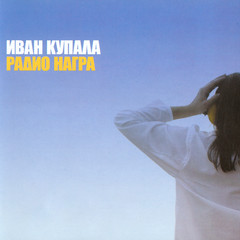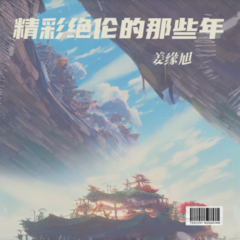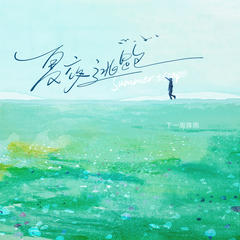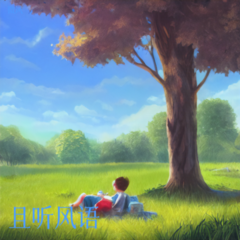Lou Reed
在摇滚史上有一个关于“地下丝绒”(The Velvet Underground)的老笑话:当年几乎没有多少人买乐队的第一张唱片,但这些买了唱片的人在后来都组建了他们自己的乐队。而真正的妙语是“每一位朋克、后朋克和先锋流行艺术家在过去的30年中都欠下了地下丝绒乐队一笔灵感的债务,哪怕只是受到了间接的影响。”在20世纪60年代末期乐队存在的日子里,他们经常被误解、经常被谩骂,但更多的是受到冷遇。不过,“地下丝绒”还是有争议地被认为是美国1965年之后最重要的摇滚乐队,它是70年代和80年代所有白人艺术噪音音乐的源泉,并且为摇滚创作中的暴戾的吉他弹奏以及带刺的现实主义的叙事歌词创作手法定下了一个普遍的标准。 你可以随意列出一大堆受其影响的著名人物的名字:David Bowie、Brian Eno、Patti Smith以及那些全部从CBGB俱乐部毕业的70年代的朋克乐手,还有The Cars、The Pretenders、Joy Division-New Order、U2、REM、Sonic Youth等等。 作为乐队的创作者,Lou Reed毫无困难地使他锋芒毕露的才能在禁忌、高价的爱和城市人的心智等方面的题材上得以展现。凭着他的对摇滚歌曲的天赋以及John Cale的实验性才能,他们演绎了许多惊世骇俗的作品。 同样地,在“地下丝绒”中着迷于矛盾声音和爆发性张力的不仅仅是Lou Reed和John Cale,而且还有性格内敛但极具力量的吉他手Sterling Morrison,不知疲倦的鼓手Maureen Tucker和拥有冷若冰霜声线的Nico(尼科).Nico是一位令人陶醉的德国女模特和演员,在1966至1967年间担任着“地下丝绒”歌手一职。乐队在一系列狂暴热烈的现场演出中开始变得有名起来,不过他们依旧可以通过一些慢民谣打碎你的心。Reed为Nico写了一些他最好的情歌,包括痛苦的订婚誓言“I\'ll Be Your Mirror”(我将是你的镜子)。“地下丝绒”,简单地说,就如同他们出生的城市纽约一样是活跃的患有精神分裂症的——完全没有为它自身作出辩解。当然他们也为此付出了很高的代价,至少在短时期内。“地下丝绒”没有什么竞争对手,他们在自己的作品中完全是特立独行的,并且当1970年由于Lou Reed离队而使这支乐队实际上走到路的尽头时,他们都精疲力劲灰心丧气了。但是“地下丝绒”并非如摇滚学家们宣称的那样走在时代的前列。事实上他们的抱负是永恒的:追求艺术却没有使摇滚之心黯然失色。 不过单个的“地下丝绒”成员未必是摇滚预言家。出生于纽约布鲁克林的Lou Reed是一个会计师的儿子,他从小就学会了弹奏古典钢琴,14岁时就录制了他的第1张唱片。后来他进入了Syracuse大学追寻更多的文学灵感,并在当地酒吧与Sterling Moorrison一起演出。但大学毕业后Lou Reed放弃了他写一本伟大的美国小说的理想,他的第一份工作是给唱片公司作曲。Lou Reed在1964年认识了John Cale。Cale出生在威尔士,在伦敦学习现代音乐,由于获得伯恩斯坦奖学金来到了美国。John Cale被Lou Reed所创作的很特别的歌曲所打动,两人决心组建一支真正的乐队来演绎这些歌曲。在招募了Sterling Morrison和一位鼓手Angns Maclise之后,他们便上路了。 在考虑了如“战争之锁”、“掉落的鞋钉”名字之后,他们把队名定为“地下丝绒”(据说这是一本关于施虐——受虐狂的平装书的标题)。乐队开始排练并在一些实验电影中露面,不久Maclise退出乐队,Lou Reed和Sterling Morrison找来一位大学校友的妹妹Maureen Tucker担任了乐队鼓手。Tucker是一位计算机键盘操作员,她精确的节奏融合在了4/4拍的鼓的进行中,这也成为了“地下丝绒”的一个标志。 流行艺术的“国王”——Andy Warhol第一次看到乐队的演出是在1965年的格林威治村的比兹拉咖啡店,他当即意识到了“地下丝绒”的原创性和重要性,并马上与他们签约。作为该乐队的经理人,他安排乐队作大量的巡回演出,并利用他的个人知名度设法使乐队与MGM唱片公司的一个分支机构Verve唱片签下了合约。作为一位制作人,Warhal有着极为敏锐的感觉,他意识到Lou Reed叙事性歌曲创作下潜藏着的浪漫主义的力量,并将Nico介绍进乐队中作为一个歌手补充了演唱的份量。他同时鼓励Lou Reed最大限度地施展词曲作者的才华。在录制“地下丝绒”首张专辑《The Velvet Underground And Nico》(地下丝绒和尼科)时,Warhal向唱片公司施压并坚持将他Andy Warhal的名字列在封套上。这张唱片的推出,是录音界的一个重要事件。不过这张被认为最佳摇滚专辑之一的唱片由于种种原因被推迟了1年才推出,而且出版后由于“披头士”专辑《佩珀军士》的热卖而导致了“地下丝绒”专辑的被冷落,那时候极少有人认识到该专辑的价值。 从某种意义上讲,该专辑的出版也是乐队解散的开始。在专辑不受欢迎之后,乐队与Warhol分道扬镳,Nico成为了一位单独发展的艺人。而“地下丝绒”为了他们自己,也为了他们那些少得可怜的歌迷们,继续坚持下去。1968年1月推出了第2张专辑《White Light/White Heat》(白光/白热),其中出现了更加前卫和独立的风格,而一首长达17分钟的“Sister Ray”(雷姐姐)更是成了该张专辑的一首标志性歌曲。由于Lou Reed在音乐观念上与John Cale的分歧加剧,1968年9月Cale在参加完波士顿的演出之后离开了“地下丝绒”。Doug Yule(道格·尤尔)代替了他在乐队中贝司的位置,而Lou Reed也在他的风格与听者之间做了一个平衡与调整,1969年出版的第3张专辑《The Velvet Underground》(地下丝绒)就在旋律上入耳和亲和了许多,并产生了许多有影响的歌曲。1970年,乐队的专辑《Loaded》(满载)终于进入了主流唱片市常这张专辑出现了两首热门歌曲“Sweet Jane”(甜蜜的珍妮)和“Rock N\' Roll”(摇滚乐),以及Reed最有激情的叙事民谣“New Age”(新时代)。但Reed在这张专辑正式出版之前就离开了乐队,而此时乐队即将在大众中变得流行。没有了Lou Reed的“地下丝绒”一直坚持到1973年才正式解散。 在70年代和80年代期间,Lou Reed和John Cale都保持着他们当初在乐队时的精神进行单独的个人发展。1989年他们又重新走到一起表演并录制了向Andy Warhol致敬的唱片《Songs For Drella》(为德雷拉的歌)。1993年,解散了20多年的“地下丝绒”成员重新走在一起进行了巡回演出,但由于Lou Reed和John Cale长期不和,重组的乐队再度解散。 Lou Reed在个人发展生涯中出版了许多专辑,其中1972年与David Bowie一起制作的《Transformer》(变压器)中产生了Lou Reed到目前为止唯一的一首打入排行榜前20名的热门金曲“Walk On The Wild Side”(沿着荒凉之地行走)。而John Cale则成了一位很有影响的唱片监制,曾为Stooges与Patti Smith制作了首张专辑,同时他作为一名出色的词曲作者出版了一系列专辑唱片。“地下丝绒”的其他成员如Nico也出版了几张个人唱片,1988年她在西班牙一个岛上骑自行车遭遇车祸身亡。Maureen Tucker怀孕生子,之后也出版过唱片;Steling Morrison退出了摇滚界回到大学教英文,1995年因病去世。 “地下丝绒”是摇滚史上一支极其重要的乐队,在他们短暂的艺术生涯中不断地突破自我与大胆尝试,对后来许多乐队带来了启迪和精神鼓励。他们用自己的音乐语言创造了一种来之不易的赎救之声。从某种意义上讲,“地下丝绒”拯救了摇滚的生命。 The career of Lou Reed defies capsule summarization. Like David Bowie (whom Reed directly inspired in many ways), he has made over his image many times, mutating from theatrical glam rocker to scary-looking junkie to avant-garde noiseman to straight rock & roller to your average guy. A firmer grasp of rock\'s earthier qualities has ensured a more consistent career path than Bowie\'s, particularly in his latter years. Yet his catalog is extremely inconsistent, in both quality and stylistic orientation. Liking one Lou Reed LP, or several, or all of the ones he did in a particular era, is no guarantee that you\'ll like all of them, or even most of them. Few would deny Reed\'s immense importance and considerable achievements, however. As has often been written, he expanded the vocabulary of rock & roll lyrics into the previously forbidden territory of kinky sex, drug use (and abuse), decadence, transvestites, homosexuality, and suicidal depression. As has been pointed out less often, he remained (and remains) committed to using rock & roll as a forum for literary, mature expression well into middle age, without growing lyrically soft or musically complacent. By and large, he\'s taken on these challenging duties with uncompromising honesty and a high degree of realism. For these reasons, he\'s often cited as punk\'s most important ancestor. It\'s often overlooked, though, that he\'s equally skilled at celebrating romantic joy, and rock & roll itself, as he is at depicting harrowing urban realities. Although Reed achieved his greatest success as a solo artist, his most enduring accomplishments were as the leader of the Velvet Underground in the \'60s. If Reed had never made any solo records, his work as the principal lead singer and songwriter for the Velvets would have still ensured his stature as one of the greatest rock visionaries of all time. The Velvet Underground are discussed at great length in many other sources, but it\'s sufficient to note that the four studio albums they recorded with Reed at the helm are essential listening, as is much of their live and extraneous material. "Heroin," "Sister Ray," "Sweet Jane," "Rock and Roll," "Venus in Furs," "All Tomorrow\'s Parties," "What Goes On," and "Lisa Says" are just the most famous classics that Reed wrote and sang for the group. As innovative as the Velvets were at breaking lyrical and instrumental taboos with their crunching experimental rock, they were unappreciated in their lifetime. Five years of little commercial success was undoubtedly a factor in Reed leaving the group he had founded in August 1970, just before the release of their most accessible effort, Loaded. Although Reed\'s songs and streetwise, sing-speak vocals dominated the Velvets, he was perhaps more reliant upon his talented collaborators than he realized, or is even willing to admit to this day. The most talented of these associates was John Cale, who was apparently fired by Reed in 1968 after the Velvets\' second album (although the pair have worked together on various other projects since then). Reed has a reputation of being a difficult man to work with for an extended period, and that has made it difficult for his extensive solo oeuvre to compete with the standards of brilliance set by the Velvets. Nowhere was this more apparent than on his self-titled solo debut from 1971, recorded after he\'d taken an extended hiatus from music, moving back to his parents\' suburban Long Island home at one point. Lou Reed mostly consisted of flaccid versions of songs dating back to the Velvet days, and he could have really used the group to punch them up, as the many outtake versions of these tunes that he actually recorded with the Velvet Underground (some of which didn\'t surface until about 25 years later) prove. Reed got a shot in the arm (no distasteful pun intended) when David Bowie and Mick Ronson produced his second album, Transformer. A more energetic set that betrayed the influence of glam rock, it also included his sole Top 20 hit, "Walk on the Wild Side," and other good songs like "Vicious" and "Satellite of Love." It also made him a star in Britain, which was quick to appreciate the influence Reed had exerted on Bowie and other glam rockers. Reed went into more serious territory on Berlin (1973), its sweet orchestral production coating lyrical messages of despair and suicide. In some ways Reed\'s most ambitious and impressive solo effort, it was accorded a vituperative reception by critics in no mood for a nonstop bummer (however elegantly executed). Unbelievably, in retrospect, it made the Top Ten in Britain, though it flopped stateside. Having been given a cold shoulder for some of his most serious (if chilling) work, Reed apparently decided he was going to give the public what it wanted. He had guitarists Steve Hunter and Dick Wagner (who had already played on Berlin) give his music a pop-metal, more radio-friendly sheen. More disturbingly, he decided to play up to the cartoon junkie role that some in his audience seemed eager to assign to him. On-stage, that meant shocking bleached hair, painted fingernails, and simulated drug injections. On record, it led to some of his most careless performances. One of these, the 1974 album Sally Can\'t Dance, was also his most commercially successful, reaching the Top Ten, thus confirming both Reed\'s and the audience\'s worst instincts. As if to prove he could still be as uncompromising as anyone, he unleashed the double album Metal Machine Music, a nonstop assault of unlistenable electronic noise. Opinions remain divided as to whether it was an artistic statement, a contract quota-filler, or a slap in the face of the public. While Reed has never behaved as outrageously (in public and in the studio) as he did in the mid-\'70s, there was plenty of excitement in the decades that followed. When he decided to play it relatively straight, sincere, and hard-nosed, he could produce affecting work in the spirit of his best vintage material (parts of Coney Island Baby and Street Hassle). At other points, he seemed not to be putting too much effort into any aspect of his songs ("Rock and Roll Heart"). With 1978\'s Take No Prisoners, he delivered one of the weirdest concert albums of all time, more of a comedy monologue (which not too many people laughed hard at) than a musical document. Reed had always been an enigma, but no one questioned the serious intent of his work with the Velvet Underground. As a soloist, it was getting impossible to tell when he was serious, or whether he even wished to be taken seriously anymore.At the end of the \'70s, The Bells set the tone for most of his future work. Reed would settle down; he would play it straight; he would address serious, adult concerns, including heterosexual romance, with sincerity. Not a bad idea, but though the albums that followed were much more consistent in tone, they remained erratic in quality and, worse, could occasionally be quite boring. The recruitment of Robert Quine as lead guitarist helped, and The Blue Mask (1982) and New Sensations (1984) were fairly successful, although in retrospect they didn\'t deserve the raves they received from some critics at the time. Quine, however, would also find Reed too difficult to work with for an extended period. New York (1989) heralded both a commercial and critical renaissance for Reed, and in truth it was his best work in quite some time, although it didn\'t break any major stylistic ground. Reed works best when faced with a challenge, which arrived when he collaborated with former partner John Cale in 1990 on a song cycle for the recently deceased Andy Warhol. In both its recorded and stage incarnations, this was the most experimental work that Reed had devised in quite some time. Magic and Loss (1992) returned him to the more familiar straight rock territory of New York, again to critical raves. The re-formation of the Velvet Underground for a 1993 European live tour could not be considered an unqualified success, however. European audiences were thrilled to see the legends in person, but critical reaction to the shows was mixed, and critical reaction to the live record was tepid. More distressingly, old conflicts reared their head within the band once again, and the reunion ended before it had a chance to get to America. Cale and Reed at this point seem determined never to work with each other again (the death of Velvet Underground guitarist Sterling Morrison in 1995 seemed to permanently ice prospects of more VU projects). In 1996, the surviving Velvet Underground members were inducted into the Rock and Roll Hall of Fame, performing a newly penned song for their fallen comrade, Morrison. Reed closed the \'90s with an album that saw him explore relationships, 1996\'s Set the Twilight Reeling (many speculated that the album was biographical and focused on his union with performance artist Laurie Anderson), which didn\'t turned out to be one of Reed\'s more critically acclaimed releases. He also found time to compose music for the Robert Wilson opera Timerocker, and in 1998, released the "unplugged" album Perfect Night: Live in London. The same year, Reed was the subject of a superb installment of the PBS American Masters series that chronicled his entire career (eventually released as a DVD, titled Rock and Roll Heart). 2000 saw Reed\'s first release for Reprise Records, Ecstasy, a glorious return to raw and straightforward rock, a tour de force that many agreed was his finest work since New York. Another collaboration with Robert Wilson, POE-try, followed in 2001 and continued its worldwide stage run through the year. Including new music by Reed and words adapted from the macabre texts of Edgar Allan Poe, POE-try led to Reed\'s highly ambitious next album, The Raven. Animal Serenade, a double-disc set recorded at the Wiltern Theater in Los Angeles during his 2003 world tour, was issued in spring 2004. The live effort is Reed\'s tribute of sorts to his celebrated Rock N Roll Animal concert album, which was released 30 years before. In 2007 Reed released Hudson River Wind Meditations, a four-song experimental sound collage that celebrated both the best and worst aspects of Metal Machine Music. Reed\'s solo work ultimately cannot stack up to his Velvet output, despite its many highlights. Still, most would have to concede that with the exception of Neil Young, no other star that rose to fame in the \'60s has continued to push himself so diligently into creating work that is meaningful and contemporary. If that means he relies on stock musical and lyrical ideas at times (as Young does), it also means he\'s proved that rock can remain relevant to listeners other than hormone-crazed teenagers.


 Vanishing Act - Lou Reed
Vanishing Act - Lou Reed




























![[STATION] aespa《Dreams Come True》MV Teaser - aespa (에스파)](https://img2.kuwo.cn/wmvpic/324/79/54/2120387380.jpg?imageView2/1/w/195/h/130/format/jpg/q/60)





